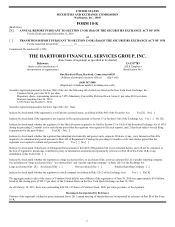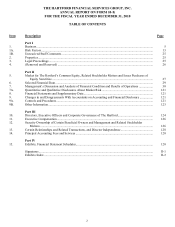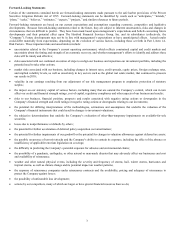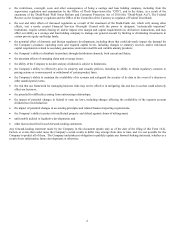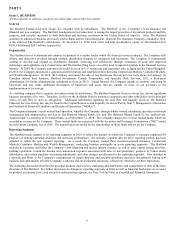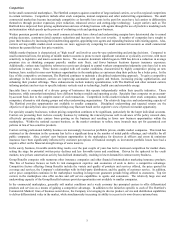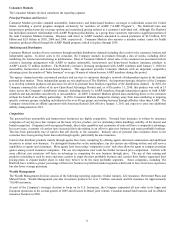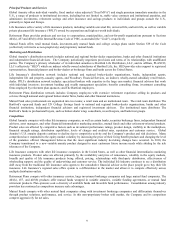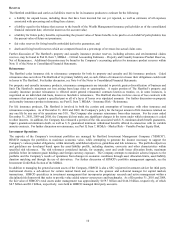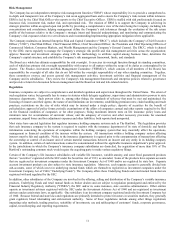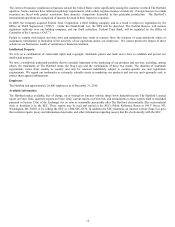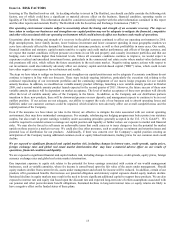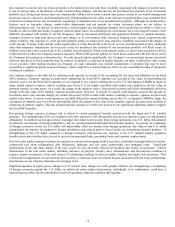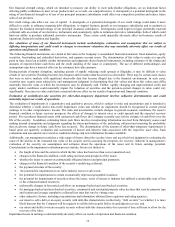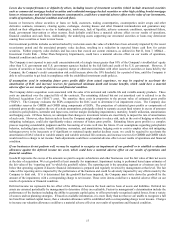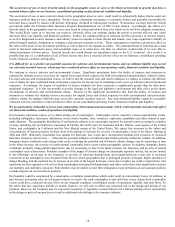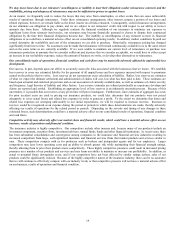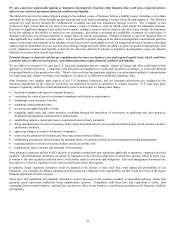The Hartford 2010 Annual Report Download - page 11
Download and view the complete annual report
Please find page 11 of the 2010 The Hartford annual report below. You can navigate through the pages in the report by either clicking on the pages listed below, or by using the keyword search tool below to find specific information within the annual report. 11
Risk Management
The Company has an independent enterprise risk management function (“ERM”) whose responsibility it is to provide a comprehensive,
in depth, and transparent view of the Company’ s risk on an aggregated basis and to ensure the Company’ s risks remain within tolerance.
ERM is led by the Chief Risk Officer who reports to the Chief Executive Officer. ERM is staffed with risk professionals focused on
insurance risk, investment risk, market risk, and operational risk. The mission of ERM is to support the Company in achieving its
strategic priorities within an agreed upon risk profile by providing a comprehensive view of the risks facing the Company, including risk
concentrations and correlations; helping management define the Company’ s risk tolerances through the evaluation of the risk return
profile of the business relative to the Company’ s strategic intent and financial underpinnings; and monitoring and communicating the
Company’ s risk exposures relative to set tolerances and recommending/implementing appropriate mitigation where applicable.
The Company maintains an internal Enterprise Risk and Capital Committee (“ERCC”), which includes the Company’ s Chief Executive
Officer (“CEO”), Chief Risk Officer, Chief Financial Officer, Chief Investment Officer, the Presidents and Chief Operating Officers of
Commercial Markets, Consumer Markets, and Wealth Management and the Company’ s General Counsel. The ERCC, which is chaired
by the CEO, meets regularly to manage the Company’ s strategic risk profile and risk management activities across the organization;
approve financial and investment strategies along with the methodology to attribute capital among business lines; determine the
Company’ s capital structure; and establish the Company’ s risk management framework, limits, and standards.
The Board as a whole has ultimate responsibility for risk oversight. It exercises its oversight function through its standing committees,
each of which has primary risk oversight responsibility with respect to all matters within the scope of its duties as contemplated by its
charter. The Finance, Investment and Risk Management Committee ("FIRMCo"), which consists of all members of the Board, has
responsibility for oversight of all risks that do not fall within the oversight responsibility of any other standing committee. Together,
these committees oversee and assess general risk management activities, investment activities and financial management of the
Company and its subsidiaries. They review the Company's risk management framework and enterprise policies related to governance
and provide a forum for discussion between management and the Board on risk and risk-related matters.
Regulation
Insurance companies are subject to comprehensive and detailed regulation and supervision throughout the United States. The extent of
such regulation varies, but generally has its source in statutes which delegate regulatory, supervisory and administrative powers to state
insurance departments. Such powers relate to, among other things, the standards of solvency that must be met and maintained; the
licensing of insurers and their agents; the nature of and limitations on investments; establishing premium rates; claim handling and trade
practices; restrictions on the size of risks which may be insured under a single policy; deposits of securities for the benefit of
policyholders; approval of policy forms; periodic examinations of the affairs of companies; annual and other reports required to be filed
on the financial condition of companies or for other purposes; fixing maximum interest rates on life insurance policy loans and
minimum rates for accumulation of surrender values; and the adequacy of reserves and other necessary provisions for unearned
premiums, unpaid losses and loss adjustment expenses and other liabilities, both reported and unreported.
Most states have enacted legislation that regulates insurance holding company systems such as The Hartford. This legislation provides
that each insurance company in the system is required to register with the insurance department of its state of domicile and furnish
information concerning the operations of companies within the holding company system that may materially affect the operations,
management or financial condition of the insurers within the system. All transactions within a holding company system affecting
insurers must be fair and equitable. Notice to the insurance departments is required prior to the consummation of transactions affecting
the ownership or control of an insurer and of certain material transactions between an insurer and any entity in its holding company
system. In addition, certain of such transactions cannot be consummated without the applicable insurance department’ s prior approval.
In the jurisdictions in which the Company’ s insurance company subsidiaries are domiciled, the acquisition of more than 10% of The
Hartford’ s outstanding common stock would require the acquiring party to make various regulatory filings.
Certain of the Company’ s life insurance subsidiaries sell variable life insurance, variable annuity, and some fixed guaranteed products
that are “securities” registered with the SEC under the Securities Act of 1933, as amended. Some of the products have separate accounts
that are registered as investment companies under the Investment Company Act of 1940 and/or are regulated by state law. Separate
account investment products are also subject to state insurance regulation. Moreover, each separate account is generally divided into
sub-accounts, some of which invest in underlying mutual funds which are themselves registered as investment companies under the
Investment Company Act of 1940 (“Underlying Funds”). The Company offers these Underlying Funds and retail mutual funds that are
registered with and regulated by the SEC.
In addition, other subsidiaries of the Company are involved in the offering, selling and distribution of the Company’ s variable insurance
products, Underlying Funds and retail mutual funds as broker dealers and are subject to regulation promulgated and enforced by the
Financial Industry Regulatory Authority ("FINRA"), the SEC and/or in, some instances, state securities administrators. Other entities
operate as investment advisers registered with the SEC under the Investment Advisers Act of 1940 and are registered as investment
advisers under certain state laws, as applicable. One subsidiary is an investment company registered under the Investment Company Act
of 1940. Because federal and state laws and regulations are primarily intended to protect investors in securities markets, they generally
grant regulators broad rulemaking and enforcement authority. Some of these regulations include among other things regulations
impacting sales methods, trading practices, suitability of investments, use and safekeeping of customers’ funds, corporate governance,
capital, record keeping, and reporting requirements.

